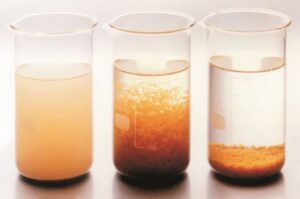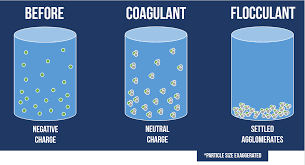Coagulants
Coagulants are substances that promote or facilitate the process of coagulation, which is the formation of a clot or solid mass from a liquid. Coagulants are commonly used in various fields, including medicine, wastewater treatment, and food processing. Here are some details about different types of coagulants:

Medical Coagulants:
In the medical field, coagulants are used to control bleeding and promote blood clotting. Some common medical coagulants include:
Antifibrinolytic agents: These drugs work by inhibiting the breakdown of blood clots. They are used to prevent or reduce bleeding in various medical conditions or during surgical procedures.
Vitamin K: Vitamin K is essential for the production of clotting factors in the blood. It is used to treat or prevent bleeding disorders caused by vitamin K deficiency.
Heparin: Heparin is an anticoagulant that prevents blood clotting. It is used in various medical settings, such as during surgeries, dialysis, and the treatment and prevention of blood clots.
Wastewater Treatment Coagulants:
Coagulants play a vital role in wastewater treatment to remove suspended particles and impurities. They help destabilize the particles, causing them to clump together and settle. Common coagulants used in wastewater treatment include:
Aluminum sulfate (alum): Alum is one of the most widely used coagulants in water treatment. It forms a gelatinous precipitate that traps suspended particles and helps in their removal.
Ferric chloride: Ferric chloride is effective in coagulating and flocculating suspended solids, as well as removing phosphates and heavy metals from wastewater.
Polymeric coagulants: These are high-molecular-weight polymers that aid in the coagulation process by bridging and aggregating particles. They are often used in combination with traditional coagulants for enhanced performance.
Food Processing Coagulants:
In food processing, coagulants are used to curdle or solidify liquids, particularly in cheese-making and tofu production. Here are a few examples:
Rennet: Rennet is an enzyme preparation obtained from the stomach lining of young mammals. It is commonly used in cheese-making to coagulate milk and separate it into curds and whey.
Calcium chloride: Calcium chloride is used as a coagulant in tofu production. It helps to solidify soy milk and form tofu curds.
Glucono delta-lactone (GDL): GDL is a naturally occurring acid that is commonly used as a coagulant in the production of soft and silken tofu.
Chemical Coagulants
These are chemical substances that are added to a liquid to promote coagulation. They work by destabilizing suspended particles, causing them to aggregate and form larger clumps that can be easily separated. Common chemical coagulants include:
- Aluminum sulfate (alum)
- Ferric chloride
- Ferrous sulfate
- Poly aluminum chloride (PAC)
- Polyacrylamide (PAM)
Organic Coagulants:
These coagulants are derived from natural sources and are often used as alternatives to chemical coagulants. They are considered more environmentally friendly. Some examples of organic coagulants include:
- Chitosan
- Tannins
- Polysaccharides (e.g., starch, cellulose
Biological Coagulants:
These coagulants are enzymes or microorganisms that promote coagulation. They are often used in specific applications, such as wastewater treatment and food processing. Examples of biological coagulants include:
- Rennet (used in cheese-making)
- Fungal coagulants (e.g., microbial rennet)

These are just a few examples of coagulants and their applications in different fields. The specific choice of coagulant depends on the intended use, the properties of the substance being treated, and the desired outcome.

